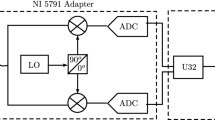Abstract
In this research, a classifier is proposed for automatic modulation classification of some common modulation schemes, i.e., BPSK, QPSK, 8-PSK and 16-QAM. Our proposed classifier considers multipath fading effects on the received signal in a non-Gaussian noise environment. Automatic modulation classification is very challenging in real-world scenarios due to fading effects and additive Gaussian mixture noise on modulation schemes. Most of the available modulation classifiers do not consider the fading effects which results in degradation of classification in a blind channel environment. In our work, the channel is supposed to be suffering from excessive additive Gaussian mixture noise and frequency selective fading resulting in low signal SNR. The estimation of the unknown channel along with noise parameters is performed using ECM algorithm and then used in maximum-likelihood classifier for the classification of modulation schemes. Simulation results are presented that show 2 dB improvement in performance than classifier which considers only Gaussian noise in the received signal.








Similar content being viewed by others
References
Dobre, O. A., Abdi, A., Bar-Ness, Y., & Su, W. (2007). A survey of automatic modulation classification techniques: Classical approaches and new developments. IET Commununication, 1(2), 137–156.
Blasco Moreno, P. (2008). Design of symbol-rate estimation and modulation classification methods within an autonomous receiver architecture for ESA satellite communications. Thesis, Technische Universitat Darmstadt.
Chavali, V. G., & da Silva, R. C. M. (2011). Maximum-likelihood classification of digital amplitude-phase modulated signals in flat fading non-Gaussian channels. IEEE Transactions on Communication, 59(8), 2051–2056.
Swami, A., & Sadler, B. M. (2000). Hierarchical digital modulation classification using cumulants. IEEE Transactions on Communications, 48(3), 416–429.
Dobre, O. A., Bar-Ness, Y. & Su, W.(2004). Robust QAM modulation classification algorithm using cyclic cumulants: Proceedings of the IEEE Wireless Communication and Networking Conference (pp. 745–748). Georgia, USA.
Kay, S. M. (1993). Fundamentals of statistical signal processing: Detection theory. Englewood Cliffs: Prentice-Hall.
Chavali, V. G. (2012). Signal detection and modulation classification in non-Gaussian noise environments. Ph. D. dissertation. Virginia Polytechnic Institute and State University.
Sklar, B. (2000). Digital communications, fundamentals and applications (2nd ed.). Englewood Cliffs: Prentice-Hall.
Haring, J., & Vinck, A. (2002). Performance bounds for optimum and suboptimum reception under class-a impulsive noise. IEEE Transactions on Communications, 50(7), 1130–1136.
Middelton, D. (1999). Non-Gaussian noise models in signal processing for telecommunications: New methods and results for class-A and class-B noise models. IEEE Transactions on Information Theory, 45, 1129–1149.
El-Mahdy, A. E. (2004). Classification of MFSK signals over time-varying flat correlated fading channels under class–an impulsive noise environment. IEEE Proceedings-Communications, 151(6), 619–626.
Alharbi, et al. (2012). Automatic modulation classification of digital modulations in presence of HF noise. EURASIP Journal on Advances in Signal Processing, 2012, 238.
AlOtaiby, T. N., Shoaib, M., Saleh, A., Hazza, A. (2013). Support vector machine based classifier for digital modulations in presence of HF noise. Electronics, Communications and Photonics Conference (pp. 1–4).
Bagga, J., Tripathi, N. (2012). Analysis of digitally modulated signal in fading environment for classification at low SNR. International Journal of Advances in Engineering, Science and Technology, 2(2), 117–122.
Azarbad, M., Hakimi, S., & Rahimzadeh, A. (2012). Automatic recognition of digital communication signal. International Journal of Energy, Information and Communications, 3(4), 21–33.
Bagga, J., & Tripathi, N. (2013). Automatic modulation classification using statistical features in fading environment. International Journal of Advanced Research in Electrical, Electronics and Instrumentation Engineering, 2(8), 3701–3709.
Stein, D. W. J. (1995). Detection of random signals in Gaussian mixture noise. IEEE Transactions on Information Theory, 41(6), 1788–1801.
Dempster, A. P., Laird, N. M., & Rubin, D. B. (1977). Maximum likelihood from incomplete data via the EM algorithm. Journal of the Royal Statistical Society (Series B), 39(1), 1–38.
Meng, X. L., & Rubin, D. B. (1993). Maximum likelihood estimation via the ECM algorithm: A general framework. Biometrika, 80(2), 267–278.
Hong, L. (2006). ML based BPSK and QPSK classifier in fading environment using EM algorithm. Proceedings of the 38th Southeastern Symposium on System Theory, TN, USA, March 5–7.
Ichiro C/O Nec Corporation Tsujimoto (1994). Parallel transmission of TDMA sync and data bursts by artificial frequency selective fade and decision feedback equalization. Patent EP0584724 A2.
Wallayt, W., et al. (2014). Performance analysis of automatic modulation classification in multipath fading environment. Proceedings of the 5th International Conference on Intelligent and Advanced Systems (ICIAS), (pp. 1, 4). Kuala Lumputer, Malaysia, June 3–5.
Acknowledgments
This research work is supported by the Research Centre of College of Computer and Information Sciences at King Saud University through Project No. RC121262. The authors are grateful for this support.
Author information
Authors and Affiliations
Corresponding author
Rights and permissions
About this article
Cite this article
Wallayt, W., Younis, M.S., Imran, M. et al. Automatic Modulation Classification for Low SNR Digital Signal in Frequency-Selective Fading Environments. Wireless Pers Commun 84, 1891–1906 (2015). https://doi.org/10.1007/s11277-015-2544-6
Published:
Issue Date:
DOI: https://doi.org/10.1007/s11277-015-2544-6




